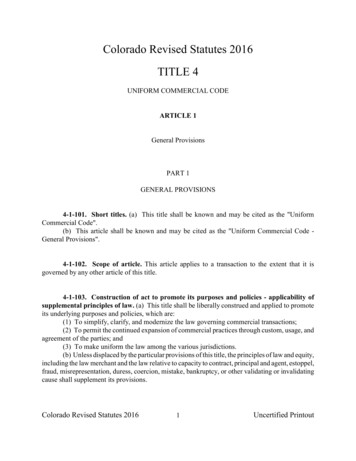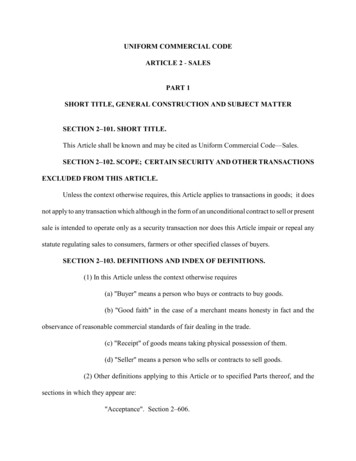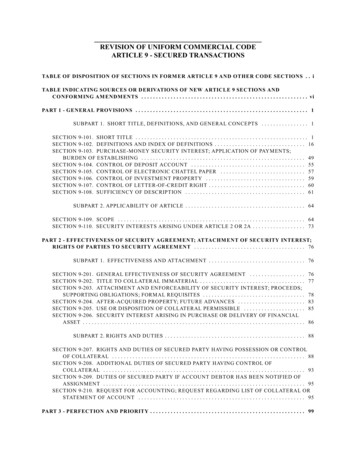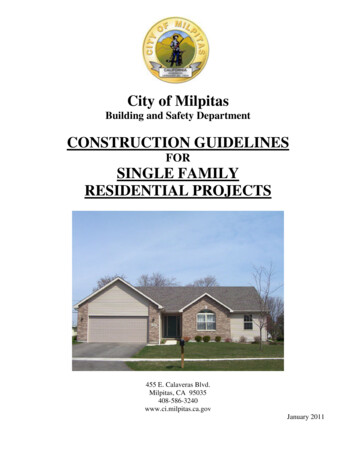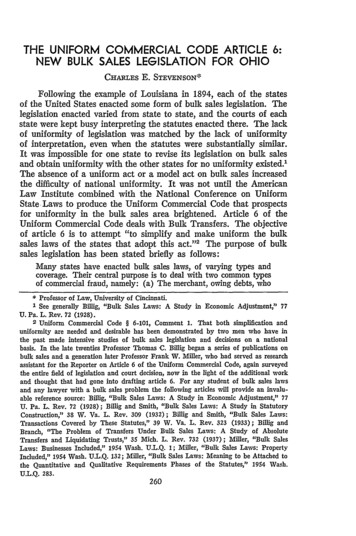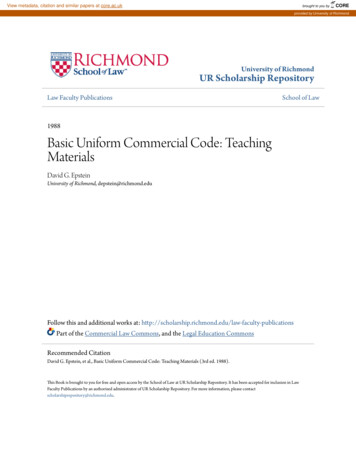
Transcription
View metadata, citation and similar papers at core.ac.ukbrought to you byCOREprovided by University of RichmondUniversity of RichmondUR Scholarship RepositoryLaw Faculty PublicationsSchool of Law1988Basic Uniform Commercial Code: TeachingMaterialsDavid G. EpsteinUniversity of Richmond, depstein@richmond.eduFollow this and additional works at: ationsPart of the Commercial Law Commons, and the Legal Education CommonsRecommended CitationDavid G. Epstein, et al., Basic Uniform Commercial Code: Teaching Materials (3rd ed. 1988).This Book is brought to you for free and open access by the School of Law at UR Scholarship Repository. It has been accepted for inclusion in LawFaculty Publications by an authorized administrator of UR Scholarship Repository. For more information, please contactscholarshiprepository@richmond.edu.
ByDean & Southeastern Bankruptcy Law Institute Professor of LawEmory University Law SchoolLate Professor of LawUniversity of MichiganR.B. Price Professor of LawUniversity of Missouri-Columbia Law SchoolRoger F. Noreen Professor of LawUniversity of Minnesota Law SchoolAMERICANWESTST. PAUL, MINN., 1988
I,American Casebook Series, the key symbol appearing on thefront cover and the WP symbol are registered trademarks ofWest Publishing Co. Registered in U.S. Patent and Trademark Office.COPYRIGHT 1973, 1983 By WEST PUBLISHING CO.COPYRIGHT 1988 By WEST PUBLISHING CO.50 West Kellogg BoulevardP.O. Box 64526St. Paul, Minnesota 55164-0526All rights reservedPrinted in the United States of AmericaEpstein, David G., 1943Basic Uniform Commercial Code teaching materials I by David G.Epstein, James A. Martin, William H. Henning, Steve H. Nickles.-3rd ed. p. cm.-(American casebook series)Includes index.ISBN 0-314-36437-41. Commercial law-United States-Cases.H., 1949. Ill. Title. IV. Series.I. Henning, William H., 1947-.II. Nickles, SteveKF8B8.E61988346.73 '07-dc19[347.3067]88-6521GIPISBN 0-314-36437-4(E., M., H. & N.) Basic UCC 3rd Ed. ACB1st Reprint-1989§
A number of students end their first year of law school asking"Will law students ever learn to understand the role of the UniformCommercial Code?" Like Marcia in Miss Peach, we believe that theanswer is "eventually, eventually." We further believe that "there's anice couple of bucks to be made" by writing a book that facilitates thisunderstanding. Hopefully, Basic Uniform Commercial Code TeachingMaterials will be such a book.These materials cover extensions of credit secured by a lien onpersonal property, sales of goods, commercial paper, credit cards, electronic funds transfer systems, and letterscredit. Some aspects ofthese subjects are regulated by federal statutes; some aspects arecovered only by judicial decisions. Notwithstanding the importantbody of federal law and common law, the Uniform Commercial Codedominates this book. And, if you are not careful, the Uniform Commercial Code will dominate you. Watch your tokus.DAVID G. EPSTEINWILLIAM H. HENNINGSTEVE H. NICKLESJanuary, 1988*xxm
ContentsPREFACE --- - - -- - -- - -- - --- --- --- -- - -- - - --- -- - - ---- - --- - --- - --- - - -- --- - -- -- - - -- - -- - --- --PagexxiiiTABLE OF CASES ----------------- xxxviiTABLE OF STATUTES ------------Chapter 1. Introduction to the Uniform Commercial CodeA. History ------------B.C.Nature of the Uniform Commercial Code-----------------------Working With the Uniform Commercial Codexliii1156PART 1. SECURED TRANSACTIONSChapter 2.Role of Security in Financing--------------------------11Introduction to Article 9 of the Uniform Commercial Code hapter 4. Creation of an Article 9 Security InterestA. Formal Requirements --B. Other Requirements162223Chapter 5.Scope of the Security Interest48A.B.After-Acquired -------Proceeds -------4950C.Future Advances ----------57Chapter 6. Secured Party and the Debtor ------------------------A. Rights of Secured Party on Default6262Chapter 3.B.Rights and Remedies of er 7.4679Priority and Perfection87A.B.Introduction to Priority ecured Party v. Buyer of the Collateral8788C.D.E.Perfection of Security Interests --------------------------------------Secured Party v. Secured Party Priority ContestsSecured Party v. Unsecured Creditors and Creditors WithJudicial LiensSecured Party v. Bank With Right of SetoffSecured Party v. Creditor With Lien "Arising by Operationof Law" --------------------98129F.G.xxv136140145
xx viSUMMARY OF CONTENTSChapter 8.Fixtures 151A. Definition of Fixture 151B.Significance of Fixture Classification ------------------------------- 1529.A.B.C.D.E.What Is Bankruptcy Law? uptcy ---------Overview of Impact of Bankruptcy on Secured ClaimsDelay in Obtaining the Collateral ----------------------------------Payment of Secured Claims in BankruptcyChapter 10.A.B.C.D.of Bankruptcy on Article Nine SecurityInterests 158158159160161173Scope of Article 9 ------------------------------------------- 208Consignments ----------Leases ------Accounts and Chattel PaperExplicit Exclusions ------PART 2,208210222225SALE OF uvv.uoChapter -- 230A. Offer and Acceptance --- 230B.Considerations ------------- 238C.D.Statute of --------------- 240Contract Modifications and the Statute of Frauds 241Chapter 12.A.B.C.Terms of the Contract 242General Considerations - 242The Parol Evidence Rule and the Code's Hierarchy of Terms 243Specific Terms 247Chapter 13, Warranty ------- 256A. General Considerations - 256B.C.D.E.F.Express Warranties -----Implied Warranties of Merchantability and FitnessLimitations on Warranty LiabilityStrict Liability in Tort (An Excursus)Expansions of Warranty Liability256264270280281Chapter 14.Breach of Performance287A. Tarr and the Code's Perfect Tender Rule------------------------ 287B.c.IlaA.li1B.Limitations on the Perfect Tender Rule -------------------------- 301Excuse of Nonperformance 30915.Remedies for Unexcused Breach 317General Rules for Computing Damages --------------------------- 317Anticipatory Repudiation ------------------------------------------------ 328
SUMMARY OF CONTENTSxxviiPage eil)1C.D.Buyers' Consequential Damages 334Goods Oriented Remedies 341i2PART 3. NEGOTIABLE INSTRUMENTS)8Chapter 16.)859)031A.B.C.Instruments and Negotiability: Introductionand Overview ----------------------------------------------The Nature of InstrumentsTypes of Instruments and How and Why They Are UsedNegotiability Generally and With Respect to Instruments34634734935973Chapter 17.JS)8102225303038404142;42:43:47156156 56 64!70l80 81!87 87301309317317328The Requisites of Negotiability:forNegotiability Under Article 3 ---------------------Chapter 18. Fundamentals of (Contract) Liability on Instru·ments -------A. Relationship Between Liability on an Instrument and onthe Underlying Obligation ------------------------------------------B. Basic Requirement of Liability on an Instrument: SignatureC. Conditions to ----------D. Liability to Whom (Herein, the Rules of Holdership)E. Discharging Liability ---F. Avoiding LiabilityChapter 19. Due-Course Status and Rights----------·-------------A. Importance of Due-Course StatusB. Limitations on Due-Course RightsC. Requisites of Due-Course StatusD. Attaining Rights Equivalent to Holder in Due CourseE. Extra-Code Restrictions on Attaining Holder-In-DueCourse Status and Equivalent Rights 0459460462469487495Chapter 20. Special Concerns With Checks 505A. Fundamentals of the Check Collection System (Herein, Too,the Interface of Articles 3 and 4) -------------------------------- 505B. Relationship Between a Payor Bank and Its Checking Account Customers 541Chapter 21.Shifting Losses on Instruments Through Warranty Liability and Restitution-------------------- 586PART 4.OTHER COMMERCIAL PAPERChapter 22. Documents of TitleA. Defining DocumentsB. How Documents Control Access to the GoodsC. How (And the Extent to Which) Documents Control Title tothe Goods616616625632
xxviiiSUMMARY OF CONTENTSPageD.E.Payment Against Documents 650Credit Against Documents 654Chapter 23. Letters of CreditA. What Is a Letter of B. Commercial Letters of Credit-----------------------------------------C. What Law Governs Letters of Credit? ----------------------------D. Standby Letters of Credit ----------------------------------------------E. Revocability of a Letter of CreditF. Grounds for Dishonor by an Issuing Bank659659660667667669677INDEX ----- --- --- ---- -------- -- -- ---- ----- --- --- ---- --- ---- ---- --- -- -- ---- --- ---- ----- -695,,IIi ·i't .JL .--
1INTRODUCTIONUNIFORM COMMERCIALA. HISTORYLegislatures in every state except Louisiana have enacted theUniform Commercial Code, and the Louisiana legislature has enactedall of the Code except Articles 2, 6, and 9. The UCC is the most widelyadopted uniform law.The UCC was a joint project of the National Conference of Commissioners on Uniform State Laws * and the American Law Institute.**The UCC was not the Commissioners' first commercial law project.From 1896 to 1933, the National Conference of Commissioners onUniform State Laws drafted and recommended for adoption a numberof commercial laws including the Uniform Negotiable Instruments Law(NIL), the Uniform Sales Act, and the Uniform Conditional Sales Act.While the NIL was adopted by all states, only 34 states adopted theUniform Sales Act and only 10 states adopted the Uniform ConditionalSales Act.Work was begun on the UCC in 1945. William Schnader, aPhiladelphia lawyer and President of the National Conference of Commissioners on Uniform State Laws, describes the drafting process asfollows:"The drafting organization was such as to require any proposedprovision of the Code to run the gauntlet of several expert bodies* The National Conference of Commissioners on Uniform State Laws was organized in 1892 to promote uniformity in law,particularly in commercial transactions,through voluntary state action. Eachstate has at least three Commissioners.The Commissioners are appointed by stateofficials, usually the governor. The Commissioners meet once a year; each statevotes as a unit on each proposal. Thework of the Conference is financed primarily by the proportional assessment paid byeach state. See generally Dunham, A History of the National Conference of Commissioners on Uniform State Laws, 30 Law &Contemp.Prob. 233 (1965).**The American Law Institute wasformed in 1923 for the purpose of preparing Restatements of the common law. Seegenerally H. Goodrich & P. Wolkin, TheStory of the American Law Institute(1961).I
2UNIFORM COMMERCIAL CODECh. lbefore it could be brought before the Institute and the Conference forconsideration and final approval."At the top of the drafting organization chart was an EditorialBoard consisting of Judge Herbert F. Goodrich of the Third CircuitCourt of Appeals and Director of the Institute and two representativesapiece from the Conference and the Institute. Next was a ChiefReporter whose duties were essentially those of the Editor-in-Chief ofthe Code. There was also an Assistant Chief Reporter. Then cameReporters, one for each Article of the Code. Each Reporter wasrequired to submit his work to a group of advisers before it could gofurther. If the advisers were satisfied, then the draft could be presented to the Council of the Institute and either to the Commercial ActsSection of the Conference or to the Property Acts Section, as might beappropriate. Each of these bodies considered each draft in detail, oftenmade amendments and sometimes recommitted the draft to the Reporter and his advisers for further study and revision."There was no difficulty in finding a 'Chief Reporter'. The outstanding man in the United States to undertake this task was Professor Karl N. Llewellyn of the Columbia University Law School. Notonly was Professor Llewellyn a student of commercial law as it appeared in the law books, but he was the type of law professor who wasnever satisfied unless he knew exactly how commercial transactionswere carried on in the market place. He insisted that the provisions ofthe Code should be drafted from the standpoint of what actually takesplace from day to day in the commercial world rather than from thestandpoint of what appeared in statutes and decisions."Let me state here that the consideration of the provisions of theCode by the Council of the Institute, by the Commercial Acts Sectionand the Property Acts Section of the Conference, and by the AnnualMeetings of both bodies was by no means a perfunctory matter. Therewere vigorous debates and differences of opinion on the Code's manyprovisions, all of which had to be settled by majority vote when theycame before the two sponsoring bodies for final adoption."I can also state that what Professor Llewellyn believed should bethe articles of an ideal commercial code were not the articles as theyemerged from the crucible of debate when the Code was promulgated."Schnader, A Short History of the Preparation and Enactment of theUniform Commercial Code, 22 U.Miami L.Rev. 1 (1967). *A final text of the UCC was completed in 1951; an official editionof the Code with explanatory comments was published as the 1952Official Text. Pennsylvania was the only state to adopt this version ofthe Code. The New York State Law Revision Commission studied the1952 Official Text from 1953-56 and issued a lengthy report recommending that New York not adopt the 1952 Official Text of the UCC.This report resulted in a revised version of the Code which was* In editing cases and excerpts frombooks and articles, we have regularly andwithout indication omitted citations andII1!'1,':,footnotes. We have retained the numbering from the original text for those footnotes that we have reproduced.
1.1forrial:uit.ves1ieff oftmewasCh. 1INTRODUCTION3published as the 1958 Official Text. The UCC was again revised in1962. By 1967, every state except Louisiana had enacted the 1962Official Text of the Uniform Commercial Code. In 1972, Article 9 ofthe UCC was substantially revised. Most states have now adopted the1972 amendments to Article 9. Article 8 on investment securities wasrevised substantially in 1977, primarily to deal with uncertificatedsecurities. A new Article 2A dealing with leases was promulgated in1987. And, Articles 3 and 4, covering negotiable instruments and bankdeposits and collections, are presently under review.I go nt Notes ctst be'tenort-1. Karl Llewellyn, Chief Reporter for the Uniform Commercial Code,was not only a leading commercial law expert but also a leading legalrealist. Professor Gilmore described Llewellyn's legal philosophy as follows:out1fesNotapwasionslS oftkesthe"Karl's version of realism was affirmative, not negative, a labor oflove and not of hate. He had a life-long love for the process and craftof judging, to which his last book bears eloquent witness. Appropriately, the title of that book repeats a phrase which we may take as a keyto much of his work: The Common Law Tradition. Revolutionary ashis early writings were thought to be, Karl abhorred abrupt departures, sudden breaks and the revealed certainty of novel illumination.He was a man of tradition, of continuity, of ordered growth andgradual change.theti onrnal1ere.any;heyd be;heyed."thetionl952n ofthe:om-JCC.wasnberfoot-"There may appear to be an element of paradox in my insistenceon Karl's dislike of system-building, on his preference for the particular over the general, on his fascination with judge-made law. Overmany years his energies were devoted to the drafting of statutes; thisaspect of his work culminated in the fifteen-year ordeal of drafting theCommercial Code. Make no mistake: this Code was Llewellyn's Code;there is not a section, there is hardly a line, which does not bear hisstamp and impress; from beginning to end he inspired, directed andcontrolled it. The statute-man, one assumes, must be, as I have saidKarl was not, a system-builder, a generalizer, a despiser of the fumbling approximations of case law."It was, I believe, Karl's non-systematic, particularizing cast ofmind and his case-law orientation which gave to the statutes hedrafted, and particularly to the Code, their profound originality. Hewas a remarkable draftsman and took a never-failing interest in eventhe minutiae of the trade. His instinct appeared to be to draft in aloose, open-ended style; his preferred solutions turned on questions offact (reasonableness, good faith, usage of trade) rather than on rules oflaw. He had clearly in mind the idea of a case-law Code: one thatwould furnish guide-lines for a fresh start, would accommodate itself tochanging circumstances, would not so much contain the law as free itfor a new growth. The tastes of the practicing lawyers who advisedthe draftsmen were, in most cases, opposed to the flexible ideas of theChief Reporter: they preferred, they insisted on, a tightly-drawn stat(E . M., H. & N.) Basic UCC 3rd Ed. ACB-3
4,'i'I,1,,, IUNIFORM COMMERCIAL CODECh. 1ute, precise, detailed and rigid. Among the many drafts of the Codewhich appeared, beginning in 1946, the early drafts were in many wayscloser to Karl's conception of the Code than were the final drafts. Inthe concluding phase of the drafting, concessions were inevitably madeto what might be called political pressures: I do not mean to suggestthat these pressures were in any sense evil or malevolent. I have cometo feel that Karl saw more clearly than his critics and that the Code ashe initially conceived it might better have served the purposes of thenext fifty years. Yet Karl never lost sight of the fact that his job wasto produce, not the best Code which could ideally be put together by aband of scholarly angels, but the best Code which stood a chance ofpassage in the imperfect world of men. He cheerfully gave groundwhen he had to: the final product was indubitably his and will remainan enduring tribute to his memory."See Gilmore, In Memoriam: Karl Llewellyn, 71 Yale L.J. 813 (1962);see generally W. Twining, Karl Llewellyn and the Realist Movement (1973).2. Llewellyn prepared the following description of commercial lawpractice for lawyers returning from World War II:"The law" of commercial transactions divides for the practicinglawyer into three rough groupings of material which he must view anduse in sharply distinct ways * * *.There is first the body of rules of law which one may call counsellor's rules or rules seen from the angle of the counsellor. These haveto do with the shaping of a transaction while it is still capable of beingshaped, and they :run in terms of the degree of safety with which onecan rely on the courts to act in particular predictable fashion if thisparticular transaction in hand should come to be presented to them.For the counsellor has found that there are some solid, settled,clear rules on which he can build; they are safe, they are bedrock.But there are not as many of them as one might wish. * * * Rulesof law from a counsellor's angle set themselves up according to thedegree of solidity and reliability which they offer as foundation andtools for building, or else according to the nature and degree of thedanger which they offer of producing an upset or other undesiredresult.The second grouping of material is the body of rules of law seenfrom the angle not of a counsellor to whom the transaction has comeearly enough for him to shape the facts, but from the angle of anadvocate to whom the transaction is brought only after the trouble hasoccurred. Bedrock law, so far as any of it is applicable, of coursebecomes important to such an advocate as setting the legal frameworkand pattern on and with the help of which he arranges the facts; in sofar, the advocate views it much as does the counsellor. But that vastrange of law which is not so clear or not so settled, of rules whoseapplication is uneven, of "trends" in decision, of rules which courtscommonly :recite only to find a way around them if their direct·application appears unfortunate-that vast :range is to the advocatenot merely an area of risk, as it is to the counsellor; it is also to theadvocate an area of opportunity: he may be able to win his case with
h.l;oderaysIn1adegestomee asthewasby ae is1em.tled, ock. ulestheand·the;iredseen:omefan has1urse/I/Orkin sovasthosemrtsirect)Cate thewithCh. 1INTRODUCTION5the help of one or more of these available though far from whollyreliable rules. The advocate sees such rules not merely as threatening"chanciness", but also as offering chances; not chances in general andin the abstract, but chances in terms of what he can manage to do withthem in this particular case in the particular available courts and,perhaps, against a particular known adversary. The advocate has hisown single and utterly concrete case in hand; the counsellor has aconcrete situation, but it is one which he must commonly view asaffected by the hazard of bad advocacy in future litigation on a similarpoint which may result in a rule of law that can upset his transactionretroactively.The third grouping of material for the lawyer who meets commercial transactions would appear to many not to involve "law" at all. Itconsists of the bodies of practical problems which present themselvesfor solution in counselling, and of the lines of practical techniquewhich are being worked out for solution of those problems: it consistsof the background, purposes, nature, legal techniques, of the commercial transactions themselves.Llewellyn, The Modern Approach to Counselling and AdvocacyEspecially in Commercial Transactions, 46 Colum.L.Rev. 167-170(1946).What is the nature of the Uniform Commercial Code? It is not"uniform." States have adopted numerous local variations. Similarly,the Uniform Commercial Code is not purely "commercial." For example, Article 2 of the UCC would apply to Johnny Mack Brown buying anew suit at the Alexander Julian Shop. Is the Uniform CommercialCode at least a true "code"?What is a "code"? As Professor Gilmore points out, not all statutesare codes." 'Code' is often used as a loose synonym for 'Statute': when thelegislature passes a statute which regulates an area previously left tothe decisional law, lawyers are apt to say that the area has been'codified.' I think that we can make a better use of the two terms: A'statute,' let us say, is a legislative enactment which goes as far as itgoes and no further: that is to say, when a case arises which is notwithin the precise statutory language, which reveals a gap in thestatutory scheme or a situation not foreseen by the draftsmen (eventhough the situation is within the general area covered by the statute),then the court should put the statute out of mind and reason its way todecision according to the basic principles of the common law. A 'code,'let us say, is a legislative enactment which entirely pre-empts the fieldand which is assumed to carry within it the answers to all possiblequestions: thus when a court comes to a gap or an unforeseen situation, its duty is to find, by extrapolation and analogy, a solutionconsistent with the policy of the codifying law; the pre-Code common
6UNIFORM COMMERCIAL CODECh. llaw is no longer available as an authoritative source. We may takeanother, subsidiary distinction between 'statute' and 'code.' When a'statute,' having been in force for a time, has been interpreted in aseries of judicial opinions, those opinions themselves become part of thestatutory complex: the meaning of the statute must now be sought notmerely in the statutory text but in the statute plus the cases that havebeen decided under it. A 'code,' on the other hand, remains at alltimes its own best evidence of what it means: cases decided under itmay be interesting, persuasive, cogent, but each new case must bereferred for decision to the undefiled code text."Gilmore, Legal Realism: Its Cause and Cure, 70 Yale L.J. 1037,1042-43 (1961).Please keep this definition of a "code" in mind while reading thecases in this book and consider whether courts are treating the UCClike a "code."(1( lldac tiSEtiSEe1n111CISE1. What does Professor Gilmore mean by the phrase "case-law Code"in note 1 on p. 3?2. Did the authors of the UCC intend for it to be a "Code"? Aresections 1-102, 1-103 and 1-104 helpful in answering this question?3. Who cares if the UCC is a case law code, true code or no code atall? Isn't this just one of those questions of interest to law professors andno one else? See generally Hillman, McDonnell & Nickles, Common Lawand Equity Under the Uniform Commercial Code (1984).malminm2.CcSl cothC}EWhether or not the Uniform Commercial Code is a "true code," it isa true statute. It is the first place to look for answers; its answerscontrol. The preceding sentence raises two problems: (1) how do youfind "answers" in the Uniform Commercial Code and (2) how do youunderstand the "answers" you find?If there is a "secret trick" to finding answers in the UniformCommercial Code, it's still secret. We don't know any magic words orphrases-any easy way to find relevant provisions of the Code. We doknow that students seem to get the knack of finding answers in theUCC as a result of having to use it again and again.Of course, finding the relevant Code provision is, at best, only halfthe battle. It is still necessary to interpret the Code provision andapply it to the particular problem. The next two pages deal with toolsof interpretation of the UCC. The :remainder of the book deals withproblems of application.soenthcothobistalCoab:imde1tio
1eaae1tell[t7,:i.tldwisrs)U)Umordob.eilfrid lsthCh. 1INTRODUCTION71. DEFINITIONSBecause "debtor" can include people who are not indebted (9-105(1)(d)) and "farm products" can include gasoline (9-109(3)), the first step ininterpreting or construing a Code provision is defining the key terms.There are a number of places in the Code to check for suchdefinitions. Section 1-201 contains 46 definitions; section 1-201 isapplicable to every article of the Code. Additionally, each articlecontains definitions of terms for purposes of that article; such definitional provisions usually are near the beginning of the article. E.g.,sections 2-103; 3-102; 4-104; 5-103; 6-102. Finally, there are definitional cross references at the end of the "Official Comment" to eachsection. Please do not depend on these citations as exhaustive. Forexample, section 2-316, dealing with exclusion or modification of warranties provides that any written disclaimer of an implied warranty ofmerchantability must, inter alia, be "conspicuous." The definitionalcross references neglect to indicate that "conspicuous" is defined insection 1-201.Notwithstanding all of the above places to check for definitions,many key UCC terms are defined nowhere in the Code. For example,article 6 of the Code applies to "bulk transfers" as that term is definedin section 6-102. Section 6-102 speaks of transfer of a "major part" ofinventory. "Major part" is nowhere defined. More than 50%? If so,more than 50% of what? Market value? Quantity?COMMENTSLaw students, lawyers, and judges naturally look to the "OfficialComments" for assistance in interpreting and construing Code provision. The comments are generally easier to read than the Code section,contain examples, and are "official." Why wrestle with the language ofthe Code when the language of the official comments is so muchclearer?It should first be noted that the label "official comments" issomething of a misnomer. The comments were not drafted by orenacted by any legislative body. Rather, the comments were written bythe committees that proposed the UCC. Second, the comments do notcompletely coincide with the Code. As noted, by Professor Skilton inthe leading article on the role of the comments, "Some commentsobviously, some comments subtly, add to or take away from the text. Itis often hard to determine the point at which 'explanation' begins totake over the work that should be done by the text." Skilton,
Uniform State Laws drafted and recommended for adoption a number of commercial laws including the Uniform Negotiable Instruments Law (NIL), the Uniform Sales Act, and the Uniform Conditional Sales Act. While the NIL was adopted by all states, only 34 states adopted the Uniform Sales Act and only 10 states adopted the Uniform Conditional

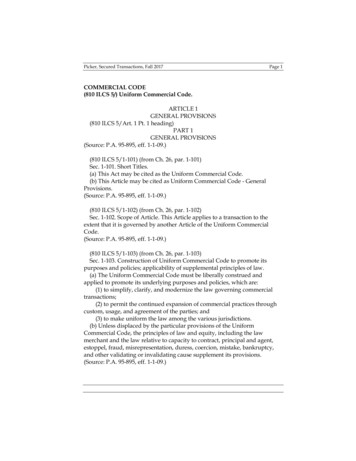
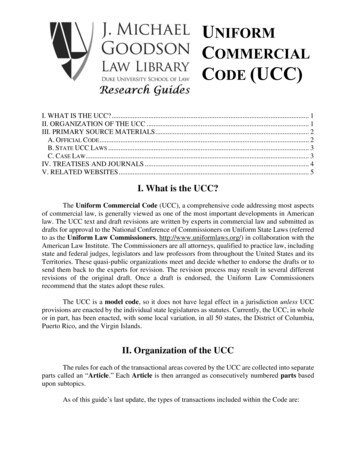
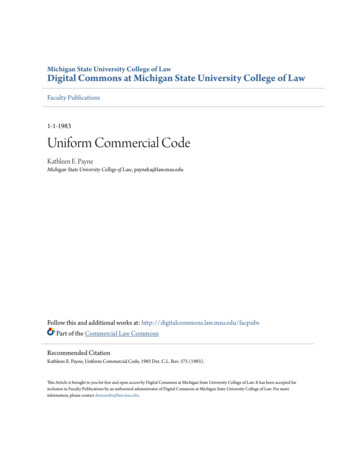
![Solar Code Development v2.5 [Read-Only]](/img/63/solar-20code-20development-20vfinal.jpg)
